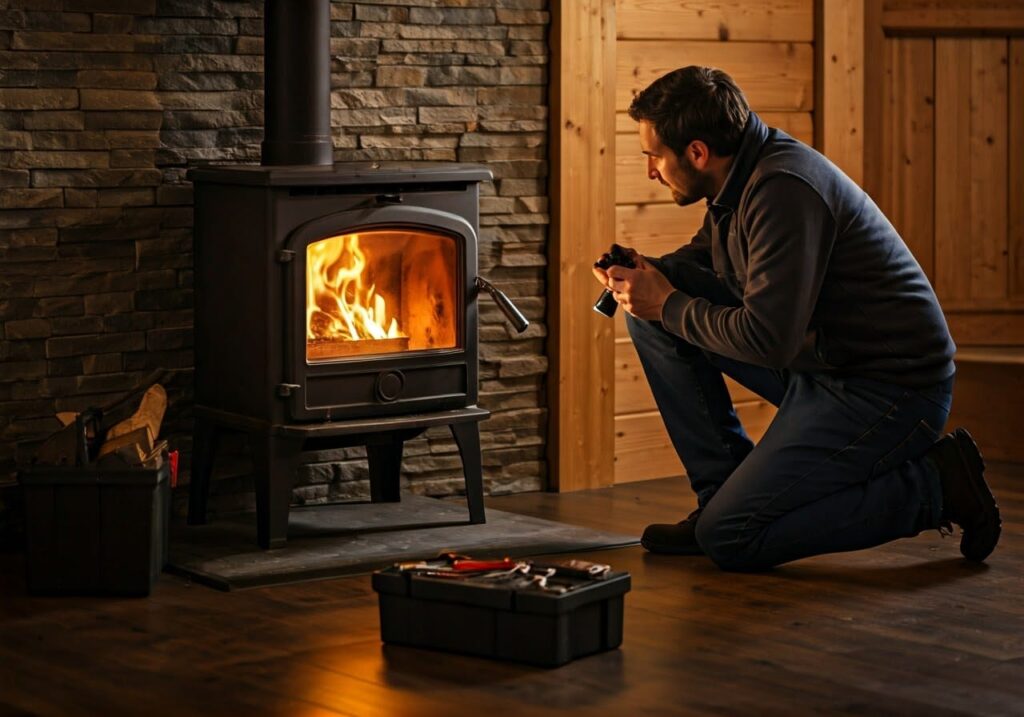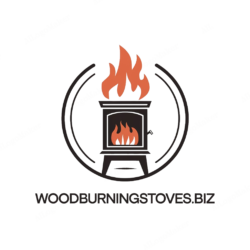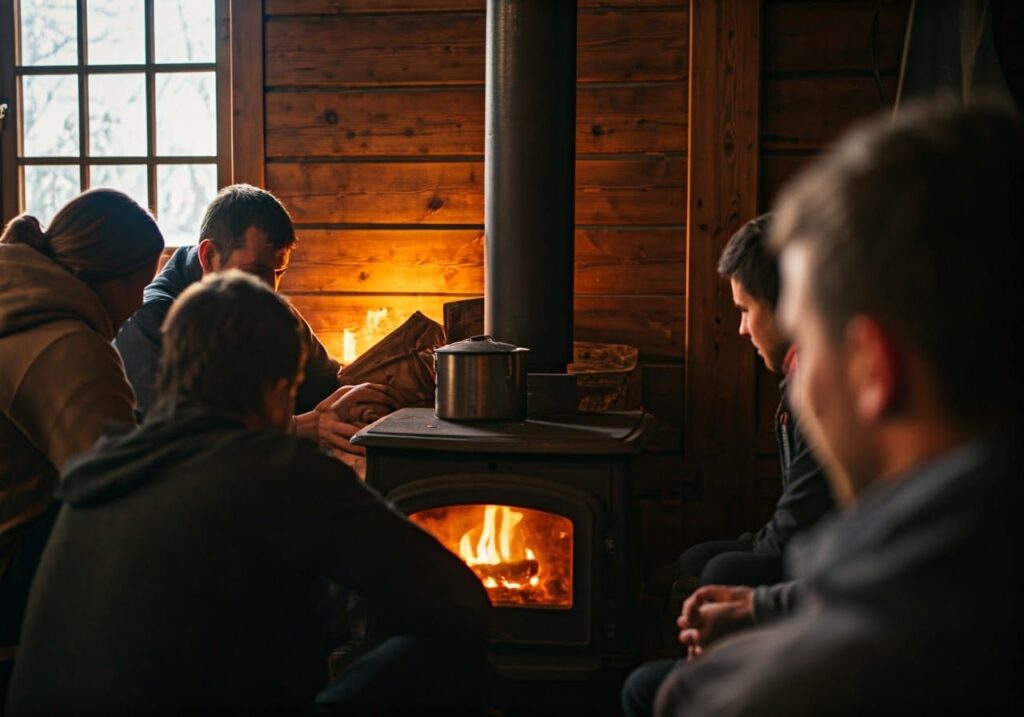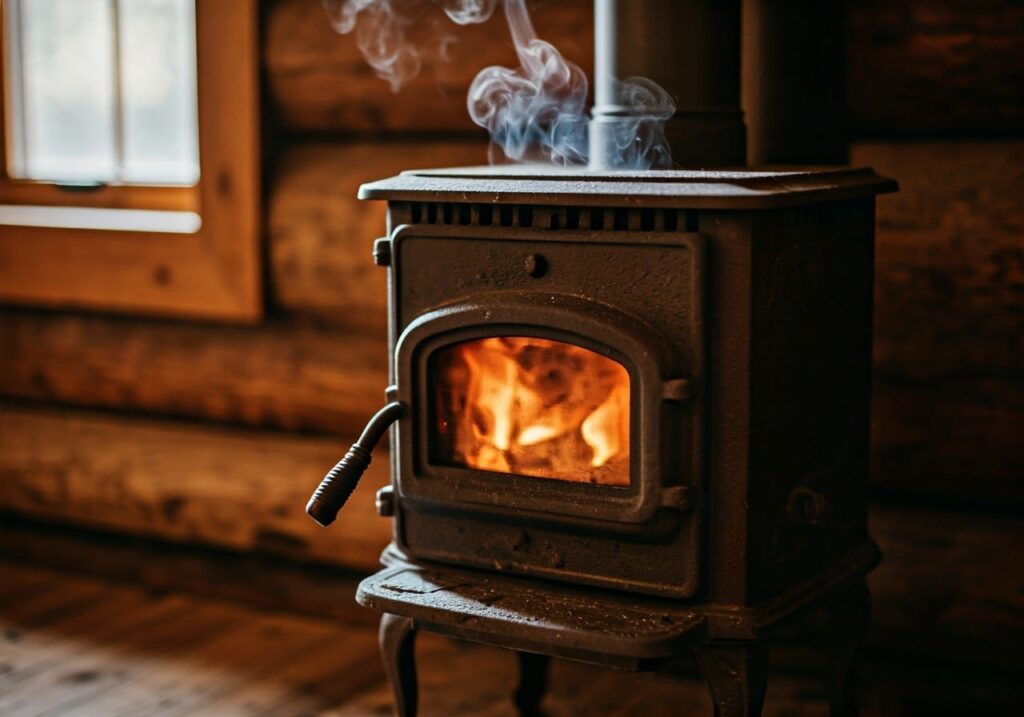Wood burning stoves are a cozy and efficient way to heat your home, but like any appliance, they can encounter issues. Troubleshooting these problems can save you time, money, and frustration. This comprehensive guide will walk you through the most Common Wood Stove Issues, providing clear solutions and referencing more in-depth supporting posts for complex problems.

- Listen to our Podcast on Troubleshooting
- 3.1 Insufficient Heat
- 3.2 Smoking Issues
- 3.3 Excessive Creosote Buildup
- 3.4 Drafting Problems
- 3.5 Lit Stove Issues
- 3.6 Smoke Reduction
- 3.7 Door Malfunctions
- 3.8 Unpleasant Odors
- 3.9 Airflow Problems
- 3.10 Chimney Blockages
- Unusual Noises from Your Wood Stove
- Rust Formation on Your Wood Stove
- Issues Specific to Pellet Stoves
- The Importance of Seasoning Wood
- Step-by-Step Stove and Chimney Cleaning
- Inspecting and Replacing Worn-Out Parts
- FAQs:
- Summary: Troubleshooting Common Wood Burning Stove Issues
Listen to our Podcast on Troubleshooting
Common Wood Stove Issues at a Glance
| Issue | Brief Solution | Supporting Post |
|---|---|---|
| Not Getting Hot Enough | Check fuel quality, airflow, and maintenance. | Why Is My Wood Stove Not Getting Hot Enough? |
| Smoking | Ensure proper drafting, chimney maintenance, and dry fuel. | How to Fix a Smoking Wood Stove |
| Excessive Creosote | Maintain regular cleaning, use dry wood, and check chimney. | Common Causes of Excessive Creosote Buildup in Wood Stoves |
| Drafting Problems | Verify chimney height, inspect for blockages, and check local weather. | Why Is My Wood Stove Not Drafting Properly? |
| Won’t Stay Lit | Check ignition, fuel moisture, and airflow. | Top Reasons Your Wood Stove Won’t Stay Lit |
| Excessive Smoke | Optimize wood drying, improve airflow, and clean the stove. | How to Reduce Smoke Coming From Your Wood Stove |
| Door Won’t Close | Inspect and clean door seals, check for warping. | Wood Stove Door Won’t Close Properly: What to Do |
| Bad Smell | Clean the stove, check for creosote, and ensure proper venting. | Why Is My Wood Stove Producing a Bad Smell? |
| Airflow Issues | Verify damper function, clean vents, and adjust window openings. | How to Fix Airflow Issues in a Wood-Burning Stove |
| Chimney Blocked | Schedule a professional cleaning, inspect for animal nests. | What to Do If Your Wood Stove Chimney Is Blocked |
Detailed Troubleshooting Guides
3.1 Insufficient Heat
- Cause: Poor fuel quality, inadequate airflow, or neglect of maintenance.
- Solution: Switch to dry, seasoned wood. Ensure all vents are open and unobstructed. Refer to Why Is My Wood Stove Not Getting Hot Enough? for detailed diagnostics.
3.2 Smoking Issues
- Cause: Inadequate drafting, poor chimney maintenance, or using damp wood.
- Solution: Check chimney for blockages, ensure it’s tall enough, and only burn dry wood. See How to Fix a Smoking Wood Stove for more.
3.3 Excessive Creosote Buildup
- Cause: Infrequent cleaning, burning green wood, or chimney issues.
- Solution: Regularly clean your stove and chimney. Always burn seasoned wood. For in-depth analysis, visit Common Causes of Excessive Creosote Buildup in Wood Stoves.
3.4 Drafting Problems
- Cause: Short chimney, blockages, or adverse weather conditions.
- Solution: Verify your chimney’s height meets local building codes. Inspect for blockages and consider weather patterns. Why Is My Wood Stove Not Drafting Properly? offers detailed advice.
3.5 Lit Stove Issues
- Cause: Poor ignition, high fuel moisture, or insufficient airflow.
- Solution: Improve your ignition method, ensure wood is well-seasoned, and check all airflow vents. Top Reasons Your Wood Stove Won’t Stay Lit provides comprehensive solutions.
3.6 Smoke Reduction
- Cause: Green wood, poor airflow, or a dirty stove.
- Solution: Opt for dry wood, enhance airflow around the stove, and regularly clean it. Find more tips in How to Reduce Smoke Coming From Your Wood Stove.
3.7 Door Malfunctions
- Cause: Dirty or damaged door seals, or stove warping.
- Solution: Clean the door seals thoroughly and inspect for any warping. Detailed fixes are available in Wood Stove Door Won’t Close Properly: What to Do.
3.8 Unpleasant Odors
- Cause: Lack of cleaning, creosote buildup, or improper venting.
- Solution: Perform a deep clean of your stove, check for and remove creosote, and ensure proper venting. Why Is My Wood Stove Producing a Bad Smell? has more.
3.9 Airflow Problems
- Cause: Malfunctioning damper, clogged vents, or poorly adjusted window openings.
- Solution: Verify your damper works correctly, clean all vents, and adjust window openings for optimal airflow. See How to Fix Airflow Issues in a Wood-Burning Stove for guidance.
3.10 Chimney Blockages
- Cause: Lack of maintenance, animal nests.
- Solution: Schedule a professional chimney sweep annually. Inspect for animal nests before each burning season. What to Do If Your Wood Stove Chimney Is Blocked offers emergency and preventive measures.
Additional Troubleshooting Scenarios
Unusual Noises from Your Wood Stove
- Cause: Loose internal components, improper installation, or worn-out parts.
- Solution: Inspect and tighten all internal parts, verify installation correctness, and replace worn-out components.
Rust Formation on Your Wood Stove
- Cause: High humidity, exposure to the elements, or poor maintenance.
- Solution: Apply a rust-inhibiting coating, ensure proper ventilation, and maintain regular cleaning schedules.
Issues Specific to Pellet Stoves
- Cause: Clogged augers, poor pellet quality, or malfunctioning ignitors.
- Solution: Regularly clean the auger system, switch to high-quality pellets, and inspect/replace the ignitor as needed.
Enhanced Preventive Measures and Maintenance Tips
The Importance of Seasoning Wood
Seasoning wood is a crucial step before using it for burning, woodworking, or construction. Freshly cut wood, also known as “green wood,” contains high moisture levels (up to 50%). Seasoning involves allowing the wood to dry over time, reducing its moisture content to 20% or lower. This process is vital for several reasons:
- Efficient Burning: Seasoned wood burns more efficiently, producing more heat and less smoke.
- Durability: Lower moisture content prevents warping, cracking, and rot in woodworking and construction projects.
- Pest Control: Dried wood is less susceptible to insect infestations and mold growth.
- Safety: Seasoned wood reduces the risk of chimney fires and structural damage caused by excessive moisture.
Proper seasoning can take several months to a few years, depending on the wood species and environmental conditions. The wait yields significant benefits, making it an essential step in wood preparation.
Step-by-Step Stove and Chimney Cleaning
Regular cleaning of your stove and chimney ensures efficient burning, reduces fire hazards, and prolongs their lifespan. Follow this step-by-step guide:
Stove Cleaning (Annual)
- Cool Down: Let the stove completely cool down.
- Remove Ashes: Scoop out ashes and dispose of them safely.
- Dismantle Parts: Take out removable parts (grates, andirons, etc.). Clean with a wire brush and mild detergent.
- Wipe Down: Use a damp cloth to wipe the stove’s exterior and interior, removing soot and creosote.
- Reassemble: Put back the cleaned parts.
Chimney Cleaning (Every 1-3 Years, Depending on Usage)
- Protect the Area: Cover the floor and furniture with drop cloths.
- Remove Debris: Use a chimney brush to push debris down into the stove or a collection container.
- Scrub the Flue: Insert the brush into the chimney pot and scrub the entire flue, working downwards.
- Vacuum: Use a vacuum cleaner to remove debris from the stove and surrounding area.
- Inspect: Visually inspect the chimney for any damages or needed repairs.
Remember: If you’re unsure or lack experience, consider hiring a professional chimney sweep for the chimney cleaning process.
Inspecting and Replacing Worn-Out Parts
Here are 200 words on Step-by-Step Inspecting and Replacing Worn-Out Parts for a Stove and Chimney:
Step-by-Step Inspecting and Replacing Worn-Out Parts
Regular inspection and timely replacement of worn-out parts ensure your stove and chimney operate safely and efficiently. Follow this guide:
Inspection (Before Each Heating Season)
- Stove Body:
- Check for rust, dents, or cracks.
- Verify all screws and bolts are tight.
- Door Seals:
- Inspect for signs of wear or damage.
- Test the seal by closing the door on a piece of paper.
- Chimney:
- Look for cracks, gaps, or missing mortar.
- Check the chimney cap for damage or blockages.
- Flue and Venting:
- Inspect for creosote buildup or blockages.
- Ensure proper clearance from combustibles.
Replacing Worn-Out Parts
- Identify Needed Replacements: Based on your inspection, determine which parts require replacement.
- Source Replacement Parts:
- Ensure compatibility with your stove/chimney model.
- Consider consulting the manufacturer or a professional.
- Replace Parts:
- Follow the manufacturer’s instructions or seek professional help for complex replacements (e.g., chimney components).
- Reinspect After Replacement:
- Verify all new parts are properly installed.
- Test the stove and chimney to ensure safe and efficient operation.
Safety Reminder: If you’re unsure about any aspect of the inspection or replacement process, consult a qualified professional to avoid potential safety hazards.
FAQs:
- Q: How often should I clean my wood stove chimney?
- A: Annually, before the burning season, and as needed based on usage.
- Q: Can I use any type of wood in my pellet stove?
- A: No, only use high-quality pellets specifically designed for pellet stoves.
Preventive Measures for a Hassle-Free Wood Burning Experience
Here are 200 words on Preventive Measures for a Hassle-Free Wood Burning Experience:
Preventive Measures for a Hassle-Free Wood Burning Experience
Implement these preventive measures to ensure a safe, efficient, and enjoyable wood burning experience:
Before the Burning Season
- Annual Maintenance:
- Inspect and clean the stove, chimney, and venting system.
- Replace worn-out parts.
- Wood Preparation:
- Season wood for at least 6 months to reduce moisture content.
- Store wood in a dry, well-ventilated area.
During the Burning Season
- Proper Burning Techniques:
- Maintain optimal stove temperature (between 300°F – 700°F).
- Ensure adequate airflow to prevent creosote buildup.
- Regular Cleaning:
- Clean the stove and chimney regularly to prevent soot and creosote accumulation.
- Remove ashes and unburned wood daily.
- Monitor Performance:
- Keep an eye on stove efficiency, smoke output, and unusual odors.
- Address any issues promptly to prevent larger problems.
Additional Safety Precautions
- Clearance and Venting:
- Maintain proper clearance between the stove and combustible materials.
- Ensure venting systems are clear and functioning correctly.
- Carbon Monoxide Detectors:
- Install and regularly test CO detectors near the stove and sleeping areas.
- Professional Inspections:
- Schedule periodic inspections with a certified professional to catch potential issues early.
Remember: A proactive approach to wood burning ensures a safe, efficient, and enjoyable experience. Stay vigilant and address any concerns promptly.
Summary: Troubleshooting Common Wood Burning Stove Issues
This comprehensive guide provides troubleshooting solutions for common wood burning stove issues, covering problems such as insufficient heat, smoking, excessive creosote, drafting issues, etc. The article outlines brief solutions and references in-depth supporting posts for complex problems. Additionally, it emphasizes the importance of preventive measures, including seasoning wood, regular stove and chimney cleaning, inspecting and replacing worn-out parts, and implementing safety precautions to ensure a hassle-free wood burning experience.
Next Steps
- Identify and Address Immediate Issues:
- Review the “Common Wood Stove Issues at a Glance” table to identify any current problems with your wood burning stove.
- Follow the brief solutions provided and refer to the corresponding in-depth supporting posts for detailed guidance.
- Schedule Preventive Maintenance:
- Plan an annual stove and chimney cleaning (before the next burning season).
- Inspect your stove and chimney for worn-out parts that may need replacement.
- Ensure all safety precautions are in place (e.g., proper clearance, functioning venting systems, and carbon monoxide detectors).
- Enhance Your Wood Burning Knowledge:
- Read the recommended supporting posts for a deeper understanding of specific issues.
- Explore additional resources on wood seasoning, proper burning techniques, and stove/chimney maintenance.
- Consider Professional Assistance:
- If you’re unsure about any aspect of troubleshooting, maintenance, or repairs, consider consulting a certified professional.
- Schedule periodic inspections with a professional to catch potential issues early and ensure your wood burning stove operates safely and efficiently.


